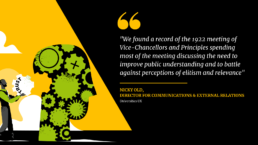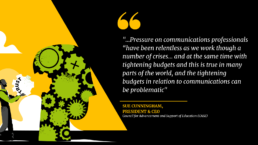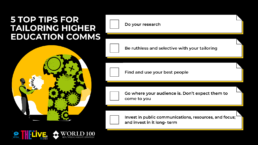On April 1st, World 100 Director Louise Simpson, hosted a panel of experts at THE Live US. The panel looked at rebuilding public trust in universities and featured Sue Cunningham, President and CEO of the Council for Advancement and Support of Education and Nicky Old, Director for Communications and External Relations for Universities UK.
Higher education institutions are frequently engaged in socially beneficial work, but without a good communications strategy it is easy for these endeavors to be missed or misrepresented by the wider world. In this session the panel explored how universities can best share their good work beyond the campus to mitigate the challenges of mistrust in science or expertise. They also tackled the importance of tailored communication in reaching different segments of society.
As well as not being a new problem, it is also not one specific to a certain country. Sue Cunningham, having lived and worked in higher education in Australia, the UK and the US, and taking into consideration different contexts and perspectives of the range of countries covered by CASE’s members, stated “that the perceptions of the value of higher education and at times the demonization of higher education, and particularly those deemed to be elite institutions, is consistent.”
But it is not all negative. Both Sue and Nicky cited research that gives a degree of reassurance. Edelman released data from their 2021 Barometer of Trust research that showed scientists as one of the most trusted societal leaders at 73%. Then there’s the Pew survey from 2019 which although initially highlighting that Republican-leaning respondents felt that higher education institutions were having a negative impact on society, showed that politicians and the public spoke positively about ‘their local institution’. This mixed picture was also shown in research conducted by Universities UK in 2018 where 48% of the public were generally positive about universities and 31% were neutral. However only a very small percentage were likely to advocate for them. This reiterated Nicky’s early comments on a lack of understanding and a lack of knowledge on what is going on in universities.

So where do we stand in terms of public trust in universities in 2021? What are the main problems? The discussion highlighted the fact that the issues of trust in the sector were not new ones; both Nicky and Sue provided examples from their organizations’ archives of meetings from as far back as 1922 where the same topics were being discussed.
Nicky Old stated: “Both Universities UK and the American Council on Education celebrated their centenaries in 2018 and both organizations have their roots in leaders in the sector coming together towards the end of World War 1 to think about ways in which Higher Education can help rebuild society and create understanding…we found a record of the 1922 meeting of Vice-Chancellors and Principles spending most of the meeting discussing the need to improve public understanding and to battle against perceptions of elitism and relevance”.
She continued “Over a century on and with the expansion of the sector you’re more likely to live somewhere near to a university, know someone who has been to a university or work at a university or be a university graduate yourself. But there is still a problem of people not really understanding what universities do and why they exist, and I think that if you don’t know something, then how can you really trust it?”
So how can we change this? Nicky commented that “it has to be an ongoing process for institutions and organisations…we have to constantly ask ourselves what we’re doing to listen, engage and welcome and to discuss things with the public…we need to be much more open and transparent…and through these actions we can earn trust, but we can never demand it”. Institutions also need to think more about their “civic mission” or “ethical obligation”. Nicky added that this is “part of the DNA of a university” and that we not only have a duty to educate the students, but that higher education has a wider obligation to “help the public understand” not only the research they are conducting but also the public benefits of a university and some of the “wonderful things that happen” within universities themselves. This poses the question as to whether universities are investing enough in getting this information out there.
Nicky discussed the increasing demand and pressure placed upon communications teams in higher education institutions, with resources being squeezed to cover all audiences, such as student communications, raising the profile of the universities, internal communications and more. Is this a question of investment or of support? Nicky added that “it is absolutely crucial that senior leaders are really buying in to this and recognize the importance of public communications linked to their civic mission and it needs to be strategic. What are you trying to achieve and why? And I think it needs to be a whole institution approach – understanding the activities and identifying the stories and the storytellers”.
Sue reiterated that particularly during the past 14 months the pressure on communications professionals “have been relentless as we work though a number of crises… and at the same time with tightening budgets and this is true in many parts of the world, and the tightening budgets in relation to communications can be problematic”. She continued by demonstrating the “powerful good” that public communications, specifically alumni advocacy, can have. For example in 2019 the state of Washington brought together all the higher education institutions, corporations and industries in the state and local government to help push through legislation resulting in investments in supporting scholarships to higher education, largely due to a huge amount of alumni advocacy.

With such importance being placed on public communications and increasing the public’s awareness of what universities are doing internally and for the community, the real crux of the issue lies in getting that communication right. Tailoring your communications appropriately is key; are you reaching the right people with the right messages? This is a common problem related to ‘public communications’ because ‘public’ covers such a wide spectrum. Nicky provided 5 top tips for tailoring higher education communications effectively:
- Do your research – you can never do too much. What do your audiences want to know? Sue stated that “too often it starts from what do we want to tell, rather than how do we want it to be received…we need to look outside in”.
- Be ruthless and selective with your tailoring – sometimes we try and shoehorn in all the messaging we can, and tell ourselves that it’s showcasing breadth and depth but in reality, it can make you look confused and chaotic to the public
- Find and use your best people - the key is knowing your best stories and your storytellers. In the past, we have often been inclined to field senior leaders, which can work for serious sectoral issues, but it does not have to be them. Find authentic people who can connect with those you are trying to reach.
- Go where your audience is. Don’t expect them to come to you - Putting a press release out and going for a piece in the newspaper or on the news isn’t always going to reach people. People are spending more time on their phones and getting their information from there.
- Invest in public communications, resources and focus; and invest in it long- term – keep on going and keep on evaluating
The World 100-led discussion at THE Live USA also covered the key topics for communications teams of trust in sources of information. Read our separate blog on this issue.


